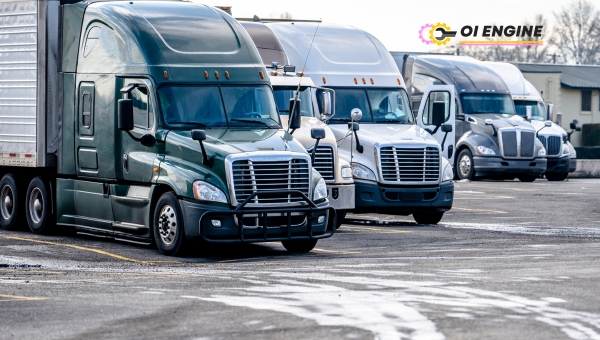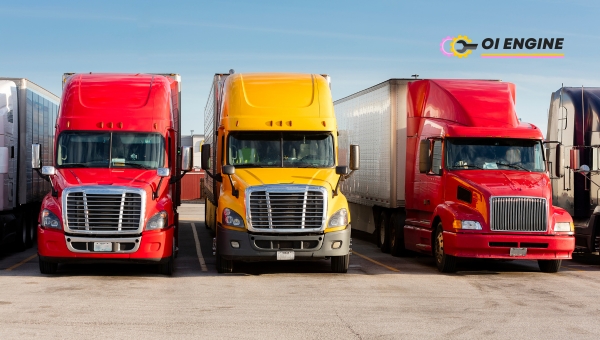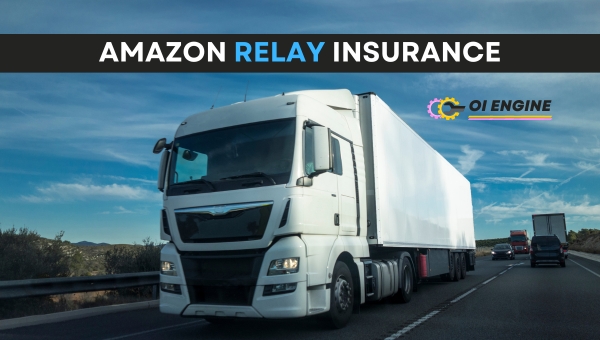Ever been puzzled about the intricacies of the “Amazon Relay Insurance Requirements”? This article gives a detailed breakdown of what you need to know when it comes to Amazon’s specific insurance requirements.
If you use or plan to use Amazon Relay, here’s what you must grasp to avoid any hurdles, and most importantly, ensure protection for your cargo, and essentially your business.
Insurance requirements under the Amazon Relay program majorly include Commercial Auto Liability Coverage, Workers’ Compensation, and General Cargo Coverage.
These policies are designed to offer protection against various types of risks that could occur during transportation or logistics operations related to Amazon Relay.
Meeting the minimum thresholds for these insurance policies is not only a requirement but it protects your interests as well as those of your workers.
Also Useful: Amazon Relay Guide: Your Key To Easy Loads
Comprehending Amazon Relay Insurance Requirements
In the world of freight transport, the details and intricacies of insurance coverage can sometimes feel overwhelming.

Especially when it comes to a service as unique as Amazon Relay. Herein, we break down this complex topic in simple terms for easier knowledge.
What are Amazon Relay Insurance Requirements?
Amazon Relay is one tool that helps truck drivers ensure their jobs and delivery routes are pre-planned and organized.
With great power comes great responsibility or in this case, specific insurance requirements. Amazon Relay insurance requirements are essentially a set of rules outlined by Amazon to ensure drivers and their cargo are adequately protected during transport operations.
They’re crucial for every party involved because they offer financial cover against untoward incidents such as accidents or damages to the cargo being transported.
For example, if I’m a driver operating under an Amazon relay system and unfortunately, an accident occurs during my shift – not only will there be potential damage to my vehicle but also the product cargo on board.
This is where relay insurance steps in offering much-needed financial protection against these unforeseen occurrences.
Why These Insurance Requirements Matter?
Knowing about these insurance requirements is one thing but do we truly know why they hold such paramount importance?
- Safety: The primary objective of requiring specific insurances is to endorse safe practices ensuring every party’s safety involved from me (the driver) through to an individual who has ordered a lamp for their home.
- Financial Security: Unpredictable events like accidents could lead me towards exorbitant costs. These bespoke insurances act as my financial shield in such scenarios.
- Maintaining Business Continuity: Damage goods could mean disastrous consequences for businesses relying on me for their deliveries – potentially disrupting continuity.
- Upholding Reputation: Meeting these vital requirements means I am working within legal boundaries thereby protecting both my reputation along with that of Amazon.
- Peace of Mind: Lastly yet importantly, knowing that I and my deliveries are insured gives me a real sense of satisfaction and peace leading to improved productivity.
At the end of the day, these Amazon Relay insurance requirements act as an effective roadmap guiding me towards safer, better practices in the freight transport world, making them vital for everyone involved.
Exploring Different Aspects of Amazon Relay Insurance Requirements
To fully comprehend the Amazon Relay Insurance Requirements, it’s essential to know its different components.

These terms can seem complex and rather intimidating, but they’re simply parts that contribute to the overall arrangement. Let’s break down these segments into simpler language, discussing each one in detail.
Commercial Auto Liability Coverage
A key part of the Amazon Relay Insurance Requirements is the Commercial Auto Liability Coverage. Now, what does this mean? Simply put, this is insurance that covers any damage you might cause to your vehicle when you’re working.
Essentially, it means that if there’s an accident while delivering goods for Amazon Relay and you are at fault, this insurance helps pay for any damage caused.
It’s vital because it takes care of liability costs which could otherwise have significant financial impact. Moreover, having Commercial Auto Liability Coverage underscores your responsibility as a driver for Amazon Relay.
It shows you are prepared and adequately covered for unforeseen accidents or mishaps that can occur during transit.
It forms a safety net not just for yourself but also assures Amazon – ensuring both parties are safeguarded from substantial losses.
Workers Compensation
Another important component within the larger puzzle of Amazon Relay insurance requirements is Workers’ Compensation.
Let me explain it simply: imagine you’re out delivering packages for Amazon Relay and something unfortunate happens – maybe you trip and fall break a leg or while lifting heavy packages suffer from back injury – then workers’ compensation has got your back! This form of insurance covers medical bills related to work injuries.
Further emphasizing its importance within the scheme of things – without Workers’ Compensation insurance someone could find themselves covering their medical expenses should an accident occur whilst on duty for Amazon Relay.
Not forgetting peace of mind knowing should anything happen while on the job – someone is looking out after us!
General Cargo Coverage
The third aspect we’ll delve into refers to General Cargo Coverage. This policy is useful when delivering goods as part of your Amazon Relay job. Imagine you’re in charge of a shipment that somehow gets lost or damaged during transit – not an ideal situation, right?
Here’s where General Cargo Coverage comes in; it helps cover the cost of items that were intentionally meant to be delivered but got lost or damaged on their way to the destination.
This coverage becomes even more crucial when the value of goods being transported is considerable. By securing general cargo insurance, you’re protecting yourself against unforeseen circumstances relating to the loss or damage of goods you’re trusted with conveying. It acts as a safety blanket ensuring your peace of mind.
Also Related: 14 Common Myths About Diesel Fuel Problems
Meeting the Minimum Specifications for Amazon’s Insurance Policies
Remember, meeting the minimum specifications for Amazon’s insurance policies is a fundamental requirement if you’re planning to use their Relay system.

It can seem like a complex task initially, but breaking it down into sections can provide clarity.
Thresholds for Different Policies
To meet Amazon Relay Insurance requirements, it’s crucial to know about the minimum thresholds for different policies.
These figures indicate what amount of coverage you need to qualify as an insured transporter. For Commercial Auto Liability Coverage, you must have at least $1 million in coverage per occurrence.
That implies if something goes wrong during the transportation process leading to any damage or liability, this policy will cover up to that specified limit.
Workers Compensation, on another hand, varies by state as certain states have their specific rules and requirements that one must comply with accordingly.
General Cargo Coverage is considered adequate if it stands at a $100,000 limit of liability per occurrence.
- The minimum threshold for Commercial Auto Liability: is $1 million.
- Workers Compensation: Varies depending on your region
- General Cargo Coverage: The Limit of Liability stands at $100000 per occurrence.
Let’s make sure that these guidelines are sorted as failing in compliance might hinder your operation with Amazon Relay Program and could potentially lead to business disruption.
Steps to Ensure Policy Compliance
Securing your operations with appropriate insurance shouldn’t be a painstaking process but rather systematic steps leading toward guaranteed compliance. Here are some simple steps I like to follow to ensure we’re staying compliant with Amazon Relay Insurance requirements:
- Review Specific Requirements: Make sure you know exactly what each insurance policy covers and its respective threshold so you choose one that caters to all your needs.
- Consult Experts and Brokers: Try engaging professionals who specialize in commercial insurance- those who understand the intricacies involved with freight transportation.
- Cross-check The Regional Rules: Frequently check your regional or state rules (especially for Worker’s Compensation) and adjust according to any changes.
- Maintain Regular Renewals: Don’t let any policy expire, keep all renewal dates alert in your schedule.
Everyone’s situation is unique, thus the insurance requirements might vary but as a general rule, when engaging with Amazon Relay ensure these requirements are taken care of.
This might seem extensive initially but all these steps are fundamental to shield yourself from potential liabilities. Take your time and do it right!
How Does Non-adherence Affect You?
Like all systems that carry governed guidelines, there are consequences when the established Amazon Relay Insurance requirements aren’t followed.

Not only can non-adherence impact you on a personal level, but it can also lead to long-term repercussions for your business.
It’s essential that these implications to avoid any unwelcome surprises and to ensure a smooth operation within the Amazon Relay.
Consequences of Not Meeting Relay Insurance Requirements
Non-compliance with the stipulated insurance requirements by Amazon Relay could lead to rather adverse outcomes. These potential consequences include:
- Eligibility Revocation: One immediate repercussion could be a loss of your eligibility status on the platform. If your insurance fails to meet Amazon’s minimum standards, you risk being removed from their list of approved carriers.
- Limited Access: Your ability to secure new gigs or access certain benefits within the relay may become limited or completely lost if you do not align with these insurance obligations.
- Penalty Charges: Violating any component of this mandatory requirement could end up costing you financially in potential penalties or fines levied by Amazon itself.
- Business Interruptions: Having coverage that does not comply can lead to forced pauses in operations until adequate coverage is secured, causing significant disruptions in business flow.
- Damage Liability: Without proper insurance coverage, any damages incurred during transit might have to be borne out-of-pocket which may put heavy financial burdens on you.
While it might seem burdensome initially, obtaining and maintaining compliance with the Amazon Relay Insurance Requirements becomes fundamental for ongoing participation and successful operation within this logistics framework offered by Amazon Relay – something one would surely prefer over facing such unwanted consequences later down the road.
Also Check: Is Accounts Receivable Considered An Asset?
FAQs
What type of insurance does Amazon Relay require?
Amazon Relay requires various types of insurance, including Commercial Auto Liability Coverage, Workers Compensation, and General Cargo insurance.
Do I need workers comp insurance for Amazon Relay?
Yes. Workers Compensation is a key requirement as part of the Amazon Relay Insurance Requirements. It provides necessary coverage in case of accidents or injuries.
What are the benefits of Amazon Relay?
Amazon Relay simplifies transportation and offers a streamlined process for carriers to provide their services. It notably increases supply chain visibility and boosts efficiency.
How much is Amazon Relay insurance per month?
The cost varies per carrier depending on risk factors such as driving history, vehicle type, and geographical location. Always consult with an insurance provider for an accurate quote.
Why do I need insurance for Amazon?
Insurance functions as a protection measure against financial loss from accidents or damages during transportation operations under the umbrella of the company’s relay program.
Do you need commercial insurance for Amazon?
Yes, Commercial Auto Liability Coverage is one crucial aspect of the mandatory insurance required by Amazon Relay.
Conclusion
Navigating through the realms of Amazon Relay Insurance Requirements is a critical process. Given the nature of the business, ensuring coverage for every potential risk means safeguarding your venture against sudden pitfalls.
These insurance requirements are not merely legal protocols, they are pillars of protection in your Amazon Relay journey.
Comprehending them wholly and adhering to them strictly does not just ensure compliance, but it also carves a path toward stability and safety in this constantly evolving digital ecosystem.
Therefore, mastering, assessing, and implementing these insurance plans meticulously should be an Amazon Relay carrier’s priority.
